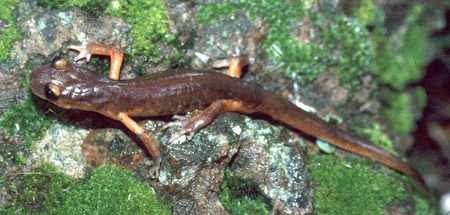- Ensatina
Taxobox
name = "Ensatina"
status = LC | status_system = IUCN3.1
status_ref = [IUCN2006|assessors=Hammerson "et al"|year=2004|id=59260|title=Ensatina eschscholtzii|downloaded=12 May 2006]
trend = down

image_width = 250px
image_caption = Monterey Ensatina
regnum =Animal ia
phylum = Chordata
classis =Amphibia
ordo =Caudata
familia = Plethodontidae
genus = "Ensatina"
genus_authority = Gray, 1850
species = "E. eschscholtzii"
binomial = "Ensatina eschscholtzii"
binomial_authority = Gray, 1850
synonyms ="Ensatina klauberi"
"Heredia oregonensis"
"Plethodon croceater"
"Urotropis platensis""Ensatina eschscholtzii" (commonly known by its genus name, "Ensatina") is a species of
salamander with a range stretching fromBritish Columbia , throughWashington ,Oregon , acrossCalifornia (where all seven subspecies variations are located), all the way down to Baja California inMexico .The Ensatina subspecies "E. e. eschscholtzii", or Monterey Ensatina, can be found in Santa Cruz, Monterey, and the California coastal mountains. They reach a total length of three to five inches, and can be identified primarily by the structure of the tail, and how it is narrower at the base. This salamander is the only type that has this tail structure and five toes on the back feet.
Males often have longer tails than the females, and many of the salamanders have lighter colored limbs in comparison to the rest of the body. The salamanders lay their eggs underground, often in threes, which then hatch directly into salamanders, skipping the usual aquatic phase.
The ensatina can usually be found under logs, brush, by or in streams and lakes, and in other moist places. Because they breathe through their pores, distress in the animal can be caused by improper handling by human hands.
The Ensatina salamander has been described as a
ring species in the mountains surrounding the Californian Central Valley. [ Wake, D. 1997 Incipient species formation in salamanders of the "Ensatina" complex. Proceedings of the National Academy of Science USA 94:7761-7767]ubspecies
*Yellow Blotched Ensatina — "E. e. croceater" (Cope, 1868)
*Monterey Ensatina — "E. e. eschscholtzii" Gray, 1850
*Large Blotched Ensatina — "E. e. klauberi" Dunn, 1929
*Oregon Ensatina — "E. e. oregonensis" (Girard, 1856)
*Painted Ensatina — "E. e. picta" Wood, 1940
*Sierra Nevada Ensatina — "E. e. platensis" (Jiménez de la Espada, 1875)
*Yellow Eyed Ensatina — "E. e. xanthoptica" Stebbins, 1949References
References
*“Ensatina Page”, Northern Prairie Wildlife Research Center, 8711 37th St. SE, Jamestown, ND 58401 USA, Viewed April 24, 2005, Updated last: November 12, 2004,
* "The Ancestor's Tale : A Pilgrimage to the Dawn of Life" (2004 ) ISBN 0-618-00583-8, Ring Species (The Salamander's Tale)External links
Wikimedia Foundation. 2010.
